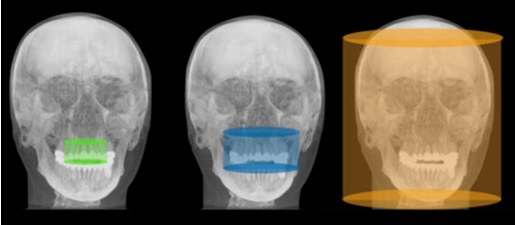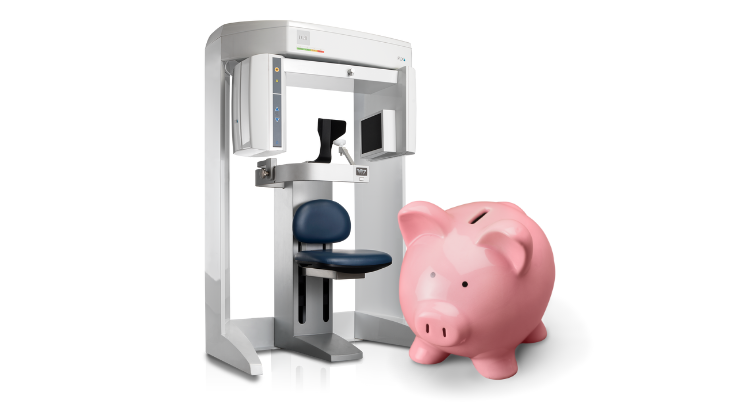How to Compare CBCT Machines: Key Specs Defined
%20(86).png)
Dentists and specialists alike are making the investment in in-house CBCT machines thanks to the promise of returned revenue from limiting outsourcing and offering additional treatment services. When thinking about buying a CBCT machine for your practice, whether it’s your first, you’re upgrading or you’re adding to a new office, you’ll benefit by taking a fair, apples-to-apples comparison of the latest systems to find the best value.
Buying dental equipment, particularly CBCT, is a significant investment, and a decision that impacts your patients, staff, and practice overall. With more manufacturers of CBCT, this technology is more accessible and affordable to doctors - but it also has created a crowded marketplace where distinguishing between brands and models can be challenging.
When researching CBCT, you’ll likely find the process familiar - almost like buying a car. Like a car, there are common features that are found among the majority of CBCT systems, just like most cars share similar basic functions. Additionally, just like car models, it’s often advanced functionality, upgraded options or “bells and whistles” that differentiate one CBCT system from another. Without a basic understanding of CBCT systems, it can be difficult to determine exactly what features are critical and which are simply nice to have.
At Renew Digital, we have over 10 years of experience working with doctors to find them the right dental imaging equipment for their needs. Because we are brand neutral and carry a wide inventory of CBCT units, as well as panoramic, pan/ceph, and intraoral scanner systems - we have extensive experience and knowledge to guide you toward the correct CBCT system to fit your clinical goals.
Today, we’re going to share a bit of our expertise on the top specifications you need to be aware of in order to make an informed CBCT machine purchase decision.
Field of View (FOV)
One of the most important specifications to understand when comparing CBCT is called field of view (FOV). The field of view indicates the anatomical area captured by the scan, typically measured in centimeters (cm). Each manufacturer sets their own field of view sizes, so they can differ greatly by brand and model.
How do you know which FOV is the right option for your practice? The FOV you’ll need is largely determined by the applications or procedures you’ll be utilizing the CBCT machine for during treatment planning. Regardless of manufacturer, dental cone beam systems are typically categorized by three FOV groups: small, medium, and large. Most medium and large FOV cone beam dental systems can often collimate down to achieve smaller FOV sizes if needed. A good rule of thumb is to go with the largest field of view that captures the needed anatomy for the procedures you’ll be performing but not so large that you’re acquiring additional anatomy that is not necessary for treatment. For example, if you plan to do localized exams like endo or single implants, a large field of view would capture more area than what you would need for these treatments.
For a full comparison of what each FOV size is used for in dental practices, continue reading our article: Dental Cone Beam FOV - Which is Right for You?

Image Quality / Voxel Size
Another major point of comparison between CBCT brands is the resolution of the image you’ll receive. The higher the resolution, the better the image quality. The quality of your CBCT image directly impacts your ability to effectively plan treatment. As an example, in endo procedures, you’ll need the highest resolution possible to ensure you can visualize the tiny details of canals. For many doctors, this is not an area worth sacrificing for a cheaper product. To compare image quality across CBCT brands, the unit of measurement is typically called a voxel.
A voxel is the smallest 3D element of the volume, represented as a cube or a box, with height, width, and depth. The larger the voxel size, the less resolution the image will have and less capability to differentiate between small structures. The voxel size is dependent on the imaging objective and the size of the unit detector.
Imaging Modules
Most of today’s CBCT systems are able to capture both 3D and 2D images. This is beneficial to most practitioners because it eliminates the need for an additional X-ray machine for cases that do not require 3D scans.
When purchasing, it’s important to know the imaging modules available with your CBCT system. Some brands, such as Planmeca and Sirona, offer a dedicated panoramic modality with an extraoral bitewing program - a desirable feature among many patients that struggle with intraoral imaging, like pediatric patients or patients with a sensitive gag reflex. Others, like i-CAT, can additionally offer cephalometric imaging in a single scan, which is extrapolated from the 3D volume.
Software Compatibility
SOFTWARE COMPATIBILITY - All CBCT machines export raw image data in the digital imaging and communications in medicine (DICOM) standard format, which can then be opened in various viewing and planning software programs.
Beyond this, because 3D scans require extensive reconstruction and algorithms not needed with 2D panoramic imaging, most CBCT machines feature a dedicated 3D imaging software to acquire, store and manage these files. It’s critical to review the software system requirements to confirm compatibility with your computers and practice network.
Upgradeability
Some dentists may feel that they aren’t quite ready for a CBCT machine and initially purchase an upgradeable 2D unit. This feature is sometimes sought after by doctors looking to expand their practice to CBCT in the future. An upgradeable unit can typically have CBCT functionality added on by the manufacturer. In addition, CBCT machines can be also upgraded to include a ceph attachment, which can be useful if you may want to add in-house orthodontic work to your service offering in the future.
When reviewing upgradeable 2D units, ask your dealer or manufacturer to confirm the cost of upgrading so you can compare this to the price of a CBCT unit.
Unit Footprint
Another important consideration when comparing CBCT machines is the unit’s footprint. Every practice is configured differently, each with different state regulations on the X-ray exam room. Knowing the actual and recommended dimensions of a CBCT system will help you configure your exam room in accordance with local regulations, while also maximizing the comfort of your staff and patients.
In this case, the actual dimensions are the true measurements of the CBCT system, while the recommended dimensions account for the movement of the CBCT unit for capturing scans. All CBCT manufacturers offer both dimensions to help account for optimal placement and operation.
Additional Terms
You may encounter other terms a CBCT manufacturer or dealer may use for their unit’s specific features and functions. As CBCT manufacturers have evolved the technology and designs of their systems, the following comparison criteria have been narrowed over the past decade. You may still see these criteria referenced on sell sheets and other online resources, but typically these are within a narrow margin of each other compared to other brands.
Effective Exposure Time
Once a very powerful selling point to CBCT manufacturers, today’s CBCT machines are fairly comparable in terms of effective exposure time. This term accounts for the time it takes to perform a scan, which will typically range under 60 seconds depending on the acquisition mode being used. The effective exposure time will generally be shown in a range because of different protocols for resolution, field of view, patient morphology and other factors that may affect the scan type needed.
Radiation Dose
Another former selling feature for CBCT systems was the radiation dose. Brands like i-CAT brought major innovation to the reduction of radiation dose, which complemented the safety of patients, particularly in pediatric use. In fact, the latest generation i-CAT FLX v17 offers an Ultra Low Dose mode which further minimizes radiation exposure.
One of the Most Important Specs: Comparing Cost
Perhaps the most obvious point of comparison when shopping for a CBCT machine is the cost. When comparing cost, it’s important to understand your upfront investment price and the cost to maintain your investment over the life of your equipment. Utilizing the above criteria will help you determine if you’re getting a good deal on a CBCT machine, or if your value will fall short in areas needed by your practice.
To help guide you through one of the most important comparison criteria, and what you can expect to pay for a dental CBCT machine today, we wrote the article: How Much Does a CBCT Machine Cost?
Fortunately, here at Renew Digital, we’ve helped our customers save 30-50% off the list prices on new CBCT machines, and we can do the same for you. All used dental equipment sold by Renew Digital is tested and retested to ensure compliance with manufacturer specifications; plus, all of our pre-owned CBCT systems are sold in “like-new” condition, complete with the latest 3D imaging software.
In addition, the sale price of used dental equipment from Renew Digital includes installation, training, and a comprehensive warranty that covers both replacement parts and onsite service. You’ll also have unlimited access to Renew Digital’s 5-star-rated customer service and support.
To learn more about these systems or to see what models are currently available, contact us online or by phone at 844-220-4963. Our sales team will help you determine the ideal model for your dental practice and your budget. Be sure to ask about our equipment trade-in program, equipment financing, and other special offers to save even more.


%20(33)-1.png)